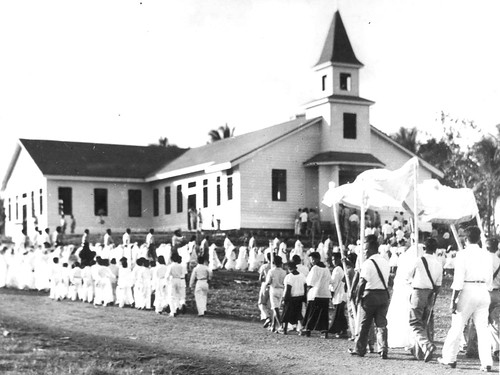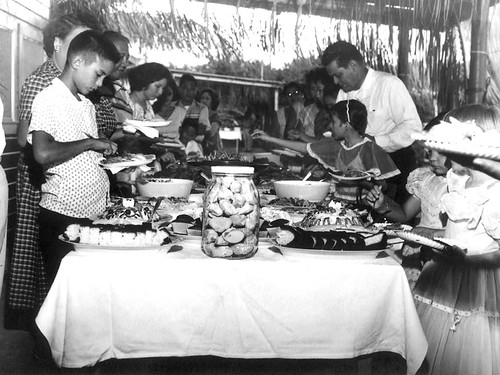Fiestas
Editor’s note: This entry was adapted and reprinted with permission from “Cultural Traditions,” from the Hale’-ta Series, Department of Chamorro Affairs, Government of Guam.
Honoring of saints
Fi’esta: Fiestas
In the long ago past, there were no fiestas. What was practiced were gatherings of clans to celebrate special events such as harvesting of a good crop, clan contests, special village events to craft a canoe, a hut building, gupot åtof or just congregating to chant and dance, tell stories and legends, to give genealogy lessons, or just getting together to socialize and have fun.
The Spanish Catholic missionaries introduced the system in which individual saints were honored and recognized on their patron feast date. This system was easily adapted into the Chamorro social celebrations at each of the village. It became an occasion to get-together with families and friends from around the island to pray and celebrate.
Today the villages celebrate particular saints who symbolize special powers. For example, San Roke, the patron saint of Barrigada, symbolizes a healer; San Isidro, the patron saint of Fena – and now, Malojloj – symbolizes the farmer; and Saint Jude, the patron saint of Sinajana, symbolizes the ability to perform the impossible.
Many Chamorros are known for devotion to their patron saints. A nobena (special rosary) is held for nine days, culminating with the traditional village procession and festal masses. Devotees from around the island attend the village procession and festal masses in order to fulfill their promesa, or special devotion to a saint. Promesa is a pledge of honor made for a favor asked of the saint, and which was bestowed. Some families hold individual nobenas in their homes, but for the most part, the nobena is held in the church and recited by a techa (prayer leader).
The traditional na’taotao tumano’ is a dinner served after the festal Mass and procession on Saturday to which all the people who participated are invited. The people of the host village provide the na’taotao tomano’ as tareha. Each family in the village would bring its share oftareha, food, drinks, or money that would go toward the cost of the dinner.
The na’taotao tomano’ is a tradition that has been in existence for many years. It was intended to feed the devotees who would come from around the island. In the past it took hours to travel the rough island roads – to the outlying agricultural villages where some of the most popular fiestas are held such as Patrosiñu at Inalåhan, San Roke in Barrigada, and San Isidro formerly in Fena, now in Malojloj. The na’taotao tomano’ ensures that the devotees are fed after the Saturday procession.
Some hold their fiesta celebration at home on a Sunday to accommodate relatives and friends who would come to attend the Sunday festal Mass. Today, these celebrations are more open.
As in other celebrations, the family would prepare for the fiesta in advance – livestock and crops are reserved, pånglao (crab) and mahongang (lobster) are caught and fattened, meats are stripped and dried for tasåhos (dried beef strips), pigs are slaughtered and the ingredients for fritåda (a pork blood and intestine stew) are cleaned and preserved.
Nobenan Niño: Novena of the Child Jesus
A Nobenan Niño is a novena held in the home of a Chamorro family or church. It is held during the Christmas season with the last day ending on either of these feasts: Christmas Eve, Christmas, New Years Eve, New Year, or on Three Kings Day. It is a generational devotion that is passed down to the female members of the family – a family promesa (promise).
Preparing for the nobena involves the construction of the bilen (nativity) to create the setting of the stable where Jesus was born and where the angels, shepherds, sheep, and the Wise Men came to adore. The bilen is built at a corner of the living room and may consist of a simple scene covered by lumot (moss) that the family would have gathered from the hålomtåno’ (jungle) and decorated with a few potted plants, or an elaborate configuration of rolling hills and mountains, stars, and Christmas ornaments.
Primarily, the family Nobenan Niño is intended for children who would be taught the prayers and songs of Christ’s birth; however, responsibility for following through with the yearly traditional devotion rests with the oldest girl in the family and continues down through succeeding generations of women.
The nobena is said for nine days. Unlike the village church fiesta, the Nobenan Niño is much simpler. On novena days, the daily servings are limited to pastries and drinks. On the finakpo’ (last rosary), the family may choose to serve a small dinner. The village nobena is held in church for nine days as well. No refreshments are served, but on the last day of the finakpo’, the parishioners may prepare and serve the traditional buñelos dågu (taro donuts), especially if the finakpo’ coincides with the misan gåyu (Midnight Mass).



